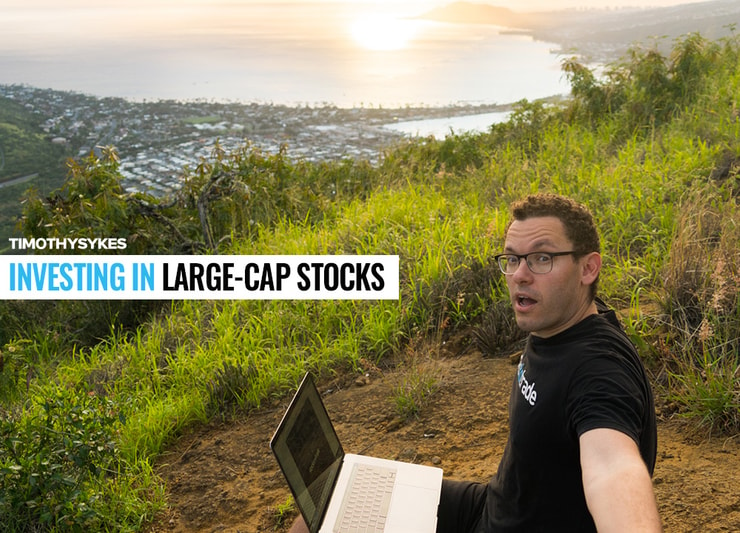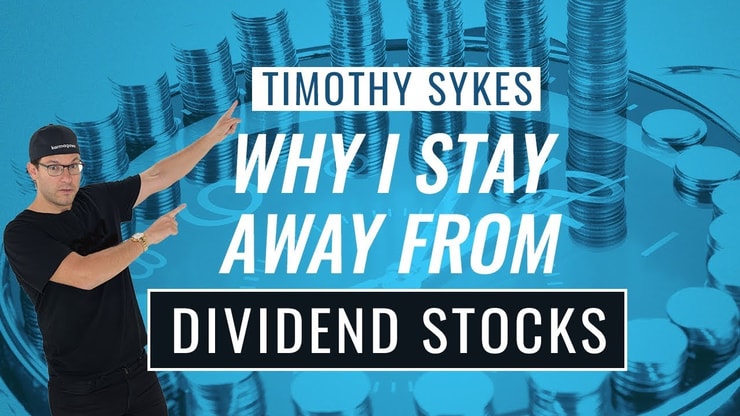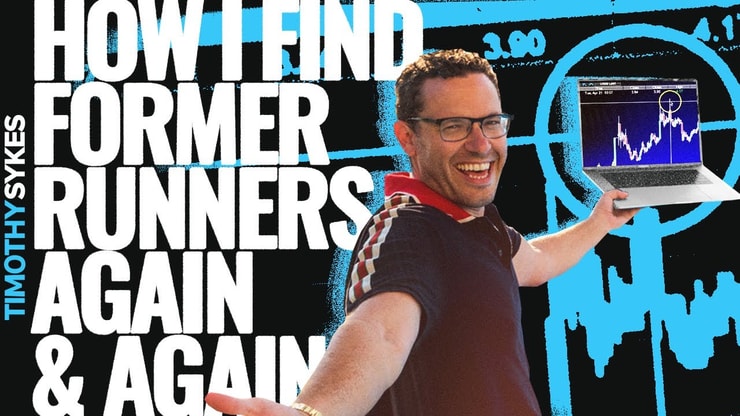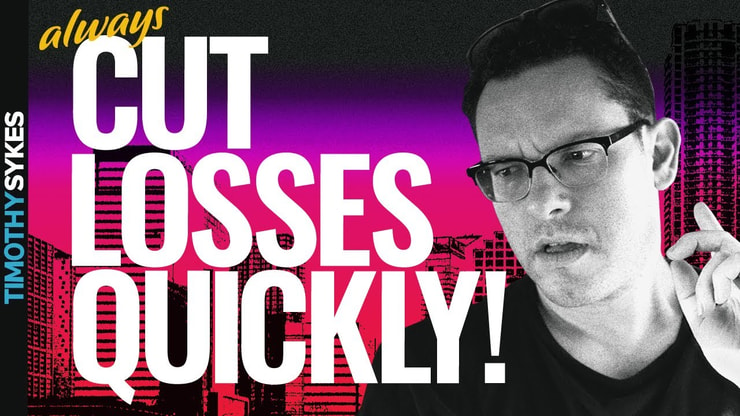When it comes to stocks, size matters.
As a trader, I focus on low-priced stocks because of their high volatility. However, this style of trading isn’t for everyone: Many traders prefer to take longer positions with more stable large-cap stocks.
Large-cap stocks are offered by big, established companies. While the share price may not move as sharply as stocks offered by smaller businesses, there’s often plenty of growth potential — if you know what to look for.
Large-cap stocks offer traders the opportunity to benefit from the continued growth of industry leaders. In this post, you’ll learn all about large-cap stocks — what they are, how to identify them, and the pros and cons of trading them.
If you want to trade small-cap stocks, check out my hotlist here!
Table of Contents
- 1 What Are Large-Cap Stocks?
- 2 Small Cap vs. Large Cap
- 3 Top 5 Large-Cap Stocks 2023
- 3.1 Shopify Inc. (NYSE: SHOP) — The E-Commerce Earnings Winner Large-Cap Stock
- 3.2 Advanced Micro Devices, Inc. (NASDAQ: AMD) — The Microsoft AI Partnership Large-Cap Stock
- 3.3 NIO Inc. (NYSE: NIO) — The Chinese EV Large-Cap Stock
- 3.4 DraftKings Inc. (NASDAQ: DKNG) — The 52-Week-Highs Large-Cap Stock
- 3.5 Coinbase Global Inc. (NASDAQ: COIN) — The Crypto Exchange Large-Cap Stock
- 4 Pros and Cons of Trading Large-Cap Stocks
- 5 How To Find and Trade Large Cap Stocks
- 6 Tips on How to Trade Large-Cap Stocks
- 7 The Bottom Line
What Are Large-Cap Stocks?

Before defining large-cap stocks, let’s clarify what “cap” means. When we start talking about caps in the stock market, we’re talking about the market cap, or market capitalization.
Market cap is the total market value of a company’s outstanding shares. It’s designated in a dollar amount.
While you could (and should) look at a company’s revenue, cash flow, and performance, the market cap gives you a different way to look at the size and scale of a company.
If you’re investing your money, stocks of different market caps slot right into a balanced portfolio. Index funds, mutual funds, and ETFs might do that for you.
Once you’ve determined the market cap, the number you come up with will put the company in a variety of different size categories. These range from nano- or micro-cap (penny stocks) to small-, mid-, large-, and mega-cap companies.
Companies with a market cap between $10 billion and $200 billion are considered large-cap stocks.
Yep, those are big numbers. That’s because these are big, established companies. Often they’ve been around for a long time, or are in a major industry.
For example, General Electric, with a market cap of about $110 billion at the time of this writing, is considered a large-cap stock.
Small Cap vs. Large Cap

What’s the difference between small- and large-cap stocks? Here’s the 411:
- Size. A large-cap company has a market cap between $10 and $200 billion. In comparison, a small-cap company falls between $300 million and $2 billion.
- Perceived value. If you’ve heard the term “blue chip stock,” large-cap stocks will often fall into this stock type category.
Blue-chip stocks are generally perceived as highly valuable stocks, which are prized for their ability to deliver long-term value.
Check out my article on blue chip stocks here.
On the other hand, small-cap companies don’t always have the same perceived value because they’re not as established, well known, or trusted. They might be newer companies, or they might be in up-and-coming industries. They don’t have a proven track record yet.
- Risk level. There can be a big difference in the volatility of small- versus large-cap stocks.
In general, the higher the volatility, the bigger the risk. Small-cap stocks are usually a lot more volatile than large-cap stocks. These spikes in price mean you can potentially earn big profits, but it also means that you could easily experience big losses.
Because large-cap stocks have much lower volatility, you don’t have as much risk associated with rapid price movement.
Investing in large cap stocks is a common strategy, but it’s not the only one. Discover more about the differences between large cap and small cap stocks.
Top 5 Large-Cap Stocks 2023
My top large-cap stocks for 2023 are:
- (NYSE: SHOP) — Shopify Inc. — The E-Commerce Earnings Winner Large-Cap Stock
- (NASDAQ: AMD) — Advanced Micro Devices, Inc. — The Microsoft AI Partnership Large-Cap Stock
- (NYSE: NIO) — NIO Inc. — The Chinese EV Large-Cap Stock
- (NASDAQ: DKNG) — DraftKings Inc. — The 52-Week-Highs Large-Cap Stock
- (NASDAQ: COIN) — Coinbase Global Inc. — The Crypto Exchange Large-Cap Stock
My watchlists change on a daily basis. That’s because I’m paying attention to market sentiment, news, and — most importantly — charts.
Large-cap stocks are especially tricky to watch. Companies like Coca-Cola Co. (NYSE: KO) and NVIDIA Corporation (NASDAQ: NVDA) fit in this category not too long ago — but after recent runs, they’re in mega-cap territory.
Use this watchlist as a learning tool. I’m not going to trade any of these stocks unless a GREAT opportunity comes around. Trading is 90% preparation, and watchlists are the most important part.
Shopify Inc. (NYSE: SHOP) — The E-Commerce Earnings Winner Large-Cap Stock
My first large-cap stock pick is Shopify Inc. (NYSE: SHOP).
SHOP fell out of mega-cap territory in 2022, after going on a nearly 400% run in 2020 and 2021…
Traders jumped ship as this stock plummeted over 80% in 2022…
Large-cap stocks have a harder time covering up their shortcomings than smaller-cap stocks. The money is either there, or it isn’t.
Momentum has been flowing back into this stock in 2023. It ran over 50% in January before it pulled back in February. Even though it spent March and April in a chopfest, it was still trending up. Then in May it hit paydirt, with a 20% gap up on earnings.
This doesn’t mean that SHOP is back to mega-cap status though. It sold its logistics business, and cut 20% of its workforce. That’s translated to a big boost in revenue.
Can it keep it up? Eventually it will have to grow.
Early signs look good.
Advanced Micro Devices, Inc. (NASDAQ: AMD) — The Microsoft AI Partnership Large-Cap Stock
My second large-cap stock pick is Advanced Micro Devices, Inc. (NASDAQ: AMD).
AI stocks are the market’s hottest sector in the first half of 2023…
Check out my AI watchlist here.
OpenAI, the company that designed the preeminent AI chat app ChatGPT, is a privately-owned company. But Microsoft Corp (NASDAQ: MSFT) has made significant investments into the company. That in turn has propelled Microsoft stock up 40% in the first four months of 2023…
That’s a heck of a move for a mega-cap stock with a $2 trillion market cap!
OK, back to AMD.
After trending up in 2023, the stock fell in April. The PC market is weak, which impacts the sales numbers of a chip maker like AMD. It also recently closed a $49 billion acquisition of another chip maker, which majorly impacts the bottom line of a stock with a $143 billion market cap in AMD.
Then it announced an AI-focused partnership with Microsoft. The market seems to like the move.
The road ahead is still rocky for AMD. But it could have a bright future ahead.
NIO Inc. (NYSE: NIO) — The Chinese EV Large-Cap Stock
My third large-cap stock pick is NIO Inc. (NYSE: NIO).
Now we’re getting to the stocks I actually trade!
Even though NIO is a large-cap stock, its share price is just above penny stock range. That was the same price range I traded it at in 2018, for a quick $1,450 profit on a technical breakout (starting stake $34,500).
Lower share prices can make a big difference in terms of exponential growth. Take a look at the 2,400% run NIO went on from March 2020 to February 2021.
Like most things in the EV sector, the 2021 hot market’s enthusiasm was premature. Make no mistake, this is not a “cheap” stock, even after having lost over 85% of its 2021 value.
It’s consistently underperformed. But it’s on this watchlist because its product is real.
China is a huge market, and NIO has a foot in the door. 1 out of every 4 cars sold in China in 2022 were EVs. Local brands account for 80% of that.
NIO made up a tiny fraction of these sales. But that isn’t what I look for when I’m trading.
I want to see hot news, and a high-volume reaction. NIO has proven that it can make that happen in the past.
DraftKings Inc. (NASDAQ: DKNG) — The 52-Week-Highs Large-Cap Stock
My fourth large-cap stock pick is DraftKings Inc. (NASDAQ: DKNG).
DKNG was a hot SPAC stock back in 2020.
SPAC stands for special purpose acquisition company, and it’s one way for a company to become publicly traded. It’s actually a heck of a lot easier for it to happen than an IPO — which means it happens quicker.
When a hot gambling company like DraftKings makes a high-momentum market debut in a hot market, the results can be explosive.
DKNG rocketed up 400% in the following months. It crashed in late 2021 and 2022, eventually losing 85% of its highs.
Now it’s back to testing 52-week highs. Its Q1 2023 earnings were better than expected.
Gambling has always been a future play. More markets are opening up as I write…
Each time the gambling pie increases, DKNG is a threat to run. That will keep it on my radar far into the future.
Coinbase Global Inc. (NASDAQ: COIN) — The Crypto Exchange Large-Cap Stock
My fifth large-cap stock pick is Coinbase Global Inc. (NASDAQ: COIN).
The other way a private company can become listed is the IPO route.
IPOs and SPACs were incredibly hot in 2021. But they became even hotter in 2022…
Verrrrry cool to see how far this $HKD Supernova has gone, it's up another 50% since my tweet just a few hours ago when it was in the $120s…now $190s, YOU GOTTA LOVE THIS KIND OF SUPERNOVA SPIKER! Good timing for my free https://t.co/fAEEdTs666 webinar tonight, THE EXACT TOPIC! https://t.co/np1x03vTvg
— Timothy Sykes (@timothysykes) July 28, 2022
Don’t get me wrong. I’m very careful when I trade IPOs and SPACs. They don’t have a chart yet — which means they can get annihilated like COIN did in 2022.
From November 2021 to the end of 2022, COIN lost 90% of its value. But it bounced in 2023, gaining over 100%.
The math is still bad for early adopters. That bounce meant they lost only 80% of their trade, not 90%.
For nimble traders, COIN spelled big gains. See why I prefer short-term trading?
COIN’s future is tied to crypto. I’m on the lookout for a bitcoin recovery in 2023. That means I’m also on the lookout for a COIN breakout.
Pros and Cons of Trading Large-Cap Stocks
I’ve alluded to some of the pros of trading large-cap stocks, but let’s just review …
Advantages
- Plenty of analyst coverage. Because there are a lot of eyes on these industry leaders, they get plenty of attention in the press and from analysts.
Analysts will devote a lot of time and effort to researching stocks like Apple or Amazon, rating them buy, hold, or sell, and giving recommendations and suggestions.
These kinds of opinions and advice can move the markets.
- More predictable rates of returns. What’s your risk tolerance? Not everyone has the stomach for trading small-cap stocks, which tend to be more volatile.
If this sounds like you, larger-cap stocks may be a better alternative. They sell real products and services, their management isn’t a mess, and their value is based on real income.
- Lots of data. Large-cap companies are highly accountable in terms of filing earnings reports, and as such, there’s plenty of company data readily available in the public sphere.
Usually, these are companies that have been around for a while, so you could conceivably have decades worth of financial and technical data to sort through.
This can help you identify long-term trends and stock movement over time.
- Dividends. Many large-cap stocks offer dividends as an added perk to shareholders.
What’s a dividend? It’s a payment that’s issued by a company to shareholders, usually (but not always) on a quarterly basis. The dividends might be issued as cash dividends or stock dividends.
- Room for growth. Remember, these large-cap companies didn’t become industry leaders without good reason.
Typically, they are able to continue to lead and innovate, and in the case of stocks like the ones detailed above, there can still be room for growth.
Disadvantages
Every rose has its thorns. Here are some of the potential disadvantages of large-cap stocks:
- Higher prices. If you’re trading with a small account, one of the biggest disadvantages of large-cap stocks is the price point.
For example, at the time of this writing, Walt Disney stock is at $102 per share, UPS is at $182, and Adobe stock is at a healthy $374.
- Slower account growth. Slow and steady may win the race, but it won’t grow your account fast. Typically, large-cap stocks are better as longer-term investments, as opposed to small-cap stocks, which can grow exponentially and offer a greater return in a short period of time…
And they can just as quickly implode.
- Competition. Large-cap stocks are offered by companies that are better known, so there’s going to be a lot more competition from institutional investors.
With low-priced stocks, which are less interesting to bigger investors, there tend to be more opportunities for traders with small accounts. This shouldn’t rule out the possibility of large-cap stocks, but it should be taken into consideration.
- They are tied to the economy. Most people think of this as a good thing — I don’t. Large-cap stocks are vulnerable to recession, rising mortgage rates and credit cards fees, the debate over student loans, and fluctuating exchange rates in Europe.
I’m content with my 5–10% goals on short-term penny stock trades, without needing to keep track of what the world thinks.
These stocks, often priced under $5, can be a great way to diversify your strategy and potentially reap substantial rewards. However, it’s essential to understand the risks involved and to do your research before trading. If you’re interested in exploring this further, check out this guide on investing in penny stocks.
How To Find and Trade Large Cap Stocks

Looking for large-cap growth stocks but not sure where to get started? These tips will point you in the right direction.
Large-Cap Stock Indicators
You’ll need to use a good stock screener to identify large-cap stocks (we’ll get to that later). You can use indicators like market cap size, but that won’t tell you if a trade is a good idea. You need a little bit more information.
Start by searching for the biggest percent gainers for the day, and then filtering the results by price. That’s what most traders look at instead of market cap.
Float will fill in the other half of the market cap equation. Float will tell you how many shares are out there. Multiply the share price by number of shares and you’ll get the market cap.
Another large-cap stock indicator you should be looking at is volume. Volume is important because it creates liquidity. This makes it easier to enter and exit a position.
News Catalysts
Now that you’ve identified a few contenders for large-cap stocks to trade based on your indicators, it’s time to start digging and doing a little research.
Start looking around at what is making these stocks move, and why. Are there any big news catalysts that you can identify? For instance, was there an earnings report just released, or did the company just announce a merger or a hot new product?
News catalysts can come in many forms. General sector news can move stocks, as well as special offers, high volume at brokers like Robinhood, and bumped up dividend yields.
High volume plus a news catalyst is a great combo when it comes to finding stocks to trade.
News catalysts can be an invitation to dig deeper in terms of fundamental research, too. It can help you determine if the news has merit. In looking at the financials of the company and their success rate in the past, you can better gauge their success in the future.
Stock Chart Patterns
If you want to make calculated, intelligent trades, you’ve got to get wise about technical analysis.
Technical analysis is where you carefully review charts to see if there are any noticeable patterns in the stock price.
I love patterns. Students in my Trading Challenge know this, and it’s one of the pillars of my teaching. I call myself a glorified history teacher because I’m all about mapping out the past in hopes of predicting what could happen in the future.
You can never know exactly what will happen, of course. But if a stock has shown the same pattern over and over in the past, the chances are higher than not that it will follow a similar trajectory in the future.
Aka — former runners can run again.
Looking at chart patterns will help you determine if it’s a good time to buy a large-cap stock, and help you figure out appropriate entry and exit points.
This is a great skill to develop overall because it can be used for all trades, whether it’s a large-cap, small-cap, or a penny stock.
Trading Plan
Repeat after me: You must have a trading plan.
Every. Single. Time.
Plenty of traders don’t think that having a trading plan is important, or they think it’s fine to keep it all in their head. WRONG.
A trading plan is key in helping you map out your trade and stick to it.
The simple act of making a trading plan forces you to think about what you hope to gain from a trade. It also forces you to think about what could go wrong in a trade.
This is extremely valuable because it makes you think about when you might want to enter a trade, and at what point you’ll cut your losses.
In the heat of a trade, it can be easy to adopt a “hold and hope” mentality or to make bad decisions. Your trading plan will keep you on track.
Stock Screener
Indicators? Technical analysis? Filters? If you’re new to trading and wondering where you can find these resources, the answer is simple: You need a great trading platform like StocksToTrade to effectively screen stocks.
The key is to choose a platform that has plenty of tools to help you do the stock research you need.
A great platform like StocksToTrade will allow you to filter down stocks to choose from. From there, you can delve into fundamental and technical data to make a more informed decision.
It’s the key for performing all of the due diligence detailed in this post.
Get your 14-day StocksToTrade trial today — only $7!
Tips on How to Trade Large-Cap Stocks

Here are some additional thoughts on best practices for trading large-cap stocks.
Create Your Own Growth Stock Watchlist
If you want to make the most tactical trades possible, create a large-cap stocks watchlist.
A watchlist is an important tool for traders at any level. With large-cap stocks, it can help you identify which ones have the most growth potential.
The watchlist is your narrowed-down list of stocks that you’re considering for trades. You don’t want it to be huge, as it’s a shortlist of contenders.
Here’s one of mine — my top stocks in 2023!
You can think of it like a list of nominees for an Academy Award. These are just the best of the best, narrowed down from all of the choices out there.
This is the list that you’ll watch to see if any of the stocks meet your specific criteria to enter a trade.
Ideally, you’ll have created a basic trading plan for each of the stocks on your watchlist, including entry and exit points. This means that if any of them meet your criteria, you’ll be ready to pounce on the trade.
I’m a huge fan of watchlists, as my students know. I send one to my Challenge students at the beginning of every trading day, so they can see what I’m noticing in the market and what I’m looking at.
Sign up here to receive my NO-COST watchlist every Sunday!
Set Stop Losses
Because large-cap stocks tend to be steadier and more reliable, many traders don’t think that it’s necessary to set stop losses.
Hey, remember the Titanic? People thought it was too big to possibly sink, but they were wrong.
That might be a dramatic example, but the fact is that even big companies can fail, and the stock prices can tank. Because of this, you’ve got to be careful about the possibility of loss, no matter how established the company is or how long it’s been around.
It’s important to cut your losses quickly with stocks of any size, so always set a stop loss. Maybe it’s a mental stop, or maybe it’s an actual stop-loss order. But make it part of your plan to determine the point you will cut losses at if things start going against your trade.
The Bottom Line
Large-cap stocks can provide many opportunities for traders.
Representing established companies and offering steadier and more reliable growth, large-cap stocks can be enticing for traders, especially if they don’t have a huge risk tolerance.
Long thought of as too slow-moving to have an impact on an account, there are plenty of opportunities for growth that don’t need to take years and years if you’re able to do the right research and identify the right opportunities.
But heck, so can real estate. I don’t have the patience to trade stocks on that kind of timeframe… you might as well put your money into much safer savings accounts or a CD!
I prefer to trade penny stocks to these much pricier stocks. The low entry point on penny stocks — which trade below $5 per share — gives small-account traders better access. They’re also better for account building purposes.
Check out my Trading Challenge to learn more about my approach, as well as everything else there is to know about trading!
Have you traded large-cap stocks? Are you a fan of them, or not so much? Share your comments and let me know!






Leave a reply